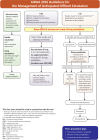All India Difficult Airway Association 2016 guidelines for the management of anticipated difficult extubation
- PMID: 28003693
- PMCID: PMC5168894
- DOI: 10.4103/0019-5049.195484
All India Difficult Airway Association 2016 guidelines for the management of anticipated difficult extubation
Abstract
Extubation has an important role in optimal patient recovery in the perioperative period. The All India Difficult Airway Association (AIDAA) reiterates that extubation is as important as intubation and requires proper planning. AIDAA has formulated an algorithm based on the current evidence, member survey and expert opinion to incorporate all patients of difficult extubation for a successful extubation. The algorithm is not designed for a routine extubation in a normal airway without any associated comorbidity. Extubation remains an elective procedure, and hence, patient assessment including concerns related to airway needs to be done and an extubation strategy must be planned before extubation. Extubation planning would broadly be dependent on preventing reflex responses (haemodynamic and cardiovascular), presence of difficult airway at initial airway management, delayed recovery after the surgical intervention or airway difficulty due to pre-existing diseases. At times, maintaining a patent airway may become difficult either due to direct handling during initial airway management or due to surgical intervention. This also mandates a careful planning before extubation to avoid extubation failure. Certain long-standing diseases such as goitre or presence of obesity and obstructive sleep apnoea may have increased chances of airway collapse. These patients require planned extubation strategies for extubation. This would avoid airway collapse leading to airway obstruction and its sequelae. AIDAA suggests that the extubation plan would be based on assessment of the airway. Patients requiring suppression of haemodynamic responses would require awake extubation with pharmacological attenuation or extubation under deep anaesthesia using supraglottic devices as bridge. Patients with difficult airway (before surgery or after surgical intervention) or delayed recovery or difficulty due to pre-existing diseases would require step-wise approach. Oxygen supplementation should continue throughout the extubation procedure. A systematic approach as briefed in the algorithm needs to be complemented with good clinical judgement for an uneventful extubation.
Keywords: Airway exchange catheter; difficult airway; extubation; reintubation; supraglottic airway device.
Conflict of interest statement
There are no conflicts of interest.
Figures
References
-
- Peterson GN, Domino KB, Caplan RA, Posner KL, Lee LA, Cheney FW. Management of the difficult airway: A closed claims analysis. Anesthesiology. 2005;103:33–9. - PubMed
-
- Varshney S, Karmaker S. Tracheal extubation. Contin Educ Anaesth Crit Care Pain. 2008;8:214–20.
-
- Cavallone LF, Vannucci A. Review article: Extubation of the difficult airway and extubation failure. Anesth Analg. 2013;116:368–83. - PubMed
LinkOut - more resources
Full Text Sources
Other Literature Sources


